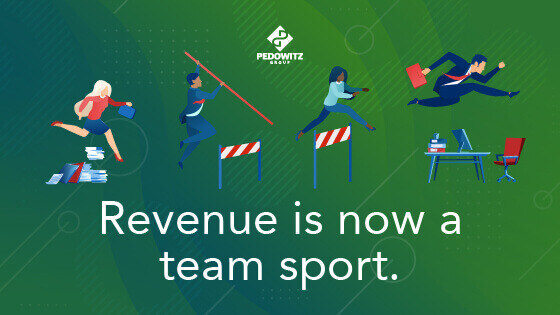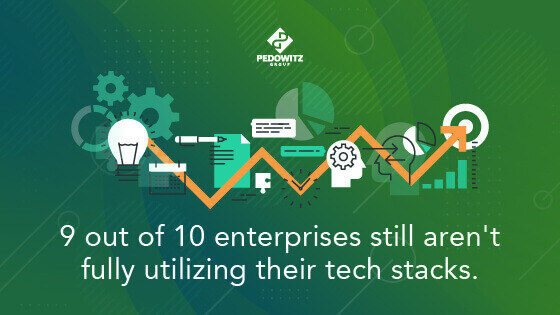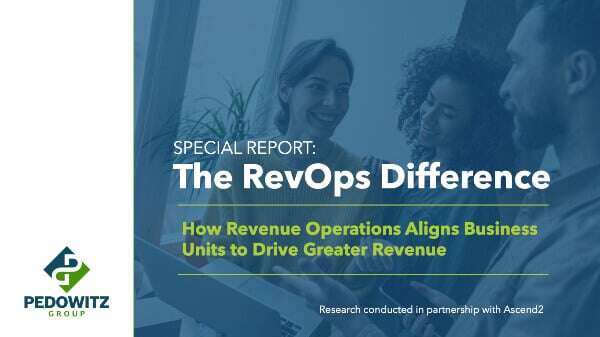Revenue Operations – or RevOps for short – is far from just the latest in a series of industry buzzwords. It’s a singularly-focused business initiative to drive more predictable and sustainable revenue. The first step to implementing it is to understand what it truly and the impact it has on enterprise revenue goals.
So, what is the big deal about Revenue Operations and why does it make such a difference?

It all boils down to 5 key areas:
Alignment
The first key is the most important to understanding the very concept of RevOps, and that’s alignment. Simply put, Revenue Operations must involve the strategic alignment of an organization’s sales, marketing and customer success functions operating in lockstep with a customer-centric focus to collectively produce repeatable revenue. If that sounds too jargon-y, you could boil it down to an even shorter five-word phrase:
Revenue is now a team sport.
It’s simply too important to only leave responsibility to it up to a sales team that is likely not your first point of contact with customers. Similarly, revenue goals are too important to put the responsibility solely in the hands of a marketing team that’s not involved with closing deals. It’s also too big for customer success or customer experience experts in your organization to manage.
Each of these functions has distinct touchpoints and perspectives of your customers. Left to their own devices, these “moneymaking” teams will ultimately work harder, not smarter. It’s unavoidable when you consider the inefficiencies of different customer personas, different processes and the challenges of proper revenue attribution.

This seems like an obvious point, and yet in a recent survey of large enterprises, (links to report landing page) only 29% have fully aligned their sales, marketing and customer experience teams. Promisingly, 69% are working toward full alignment, but they simply aren’t there yet.
But why does that matter? Because respondents overwhelmingly indicated that misalignment between these teams led to missed opportunities for revenue (55%), wasted time (59%) and poor customer experience (59%).
These are very real consequences that many enterprises are suffering through as they try to hit increasingly ambitious revenue goals with limited resources and personnel to get it done.
Sound familiar?
Maximizing opportunities with data-driven decisions
Most of these teams individually would likely consider themselves as “data-driven”. They all have access to dashboards for their automation and reporting tools. Each has KPIs they are responsible for meeting or exceedingly on a yearly or quarterly basis. Yet, many times these teams are unaware of each other’s datasets, unaware of operational data from the perspective of finance or both.
In the same survey, just 61% of overall respondents said they have insight into data from finance that allows them to make better decisions about driving revenue.
Remember that RevOps maturity – involving all three functions aligned around a customer-centric perspective wasn’t widespread among survey respondents. When you focus in on the respondents that are RevOps-identifying, however, that 61% percent number begins to skyrocket:
- 78% of fully aligned teams said they have insight.
- 75% of those identifying as “far above revenue goals” said they have insight.
- 76% of best-in-class CX companies said they have insight.
If you’re thinking of each of those as circles in a Venn diagram, they virtually overlap with each other. That’s not a coincidence!
Customer success via better customer experience (CX)
The alignment aspect of RevOps is critical, but just as critical is what your moneymaking teams are aligning around: The customer journey. While there is a general awareness of the traditional sales funnel, it’s rare for enterprises to have all these teams in lockstep to making every tactical decision with customers at the heart of it. Customers in a digital-first landscape have a plethora of options, and the main differentiating factor is what they feel you can offer them in terms of customer experience.
That’s why it’s so curious that only a paltry 18% of survey respondents rate their customer experience as “best-in-class”. Once we use our handy “zoom” function to dive deeper into RevOps-identifying organizations, the story changes again.
A much more considerable 45% of firms that identified as “achieving far above revenue goals” rate their customer experience as “best-in-class”. 41% of firms that are fully aligned internally rate the same.
Data and Technology
Our fourth key is an obvious, yet elusive one. When looking at the general pool of survey respondents, only 10% rated the optimization of their technology as “excellent”. That’s a tremendous inefficiency wherein 9 out of 10 large enterprises are not properly utilizing their sales and marketing tech stacks.

Forget about trying to make the business case for new tools in the quest to drive revenue…they haven’t even earned the trust of senior leadership on the tools they have!
For RevOps-enabled enterprises, however, that figure jumps to 33%. There’s a clear advantage in being able to align around a singular customer-centric vision throughout your organization, then leveraging your entire tech stack with that one all-important focus.
Employee Experience
The final key has truly grown in importance during the current phenomenon colloquially known as “The Great Resignation”. With enterprise talent at such a premium, companies have to shore up any weaknesses when it comes to talent acquisition, development and retention.
The primary challenges to achieving this, according to survey respondents, were budget constraints (38%), poor employee experience (33%), and lack of understanding of new skills required (32%). RevOps-enabled enterprises, on the other hand, cited lack of flexibility with remote/office employees as their #1 challenge.
Their RevOps maturity means they have a more engaged and invested workforce free to focus on driving revenue rather than commonplace career concerns. From alignment to customer experience and beyond, the RevOps difference is tangible, and it could make or break your organization’s revenue goals.
Want all of this for yourself?
Our revenue operations consulting services can make it happen!





